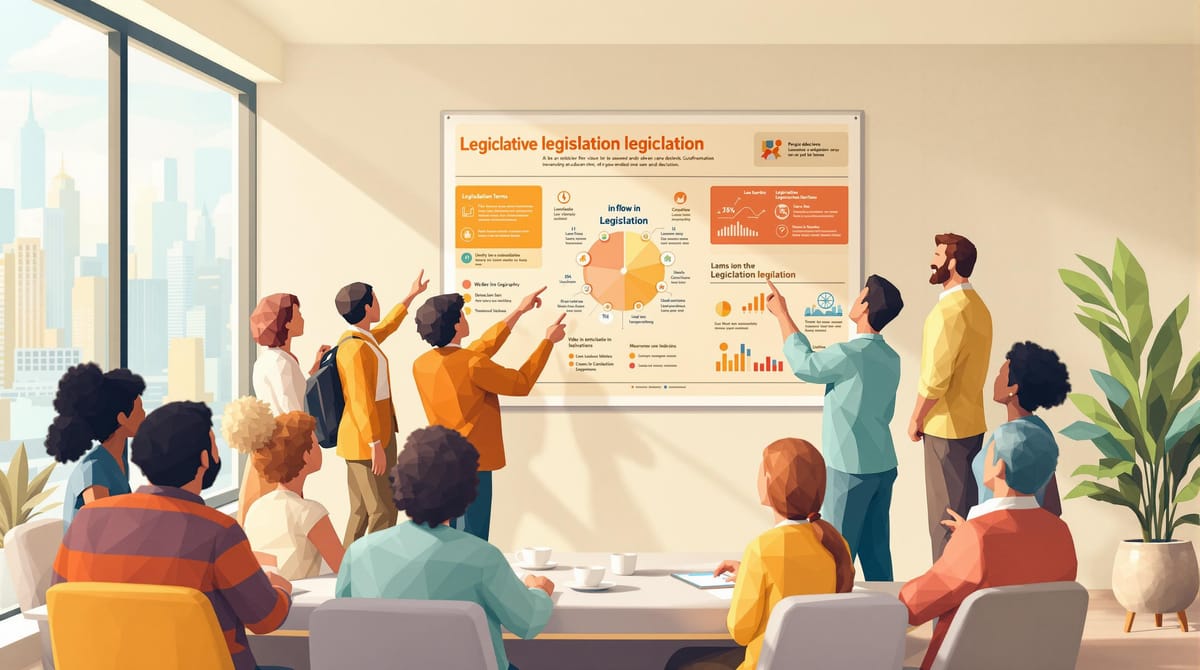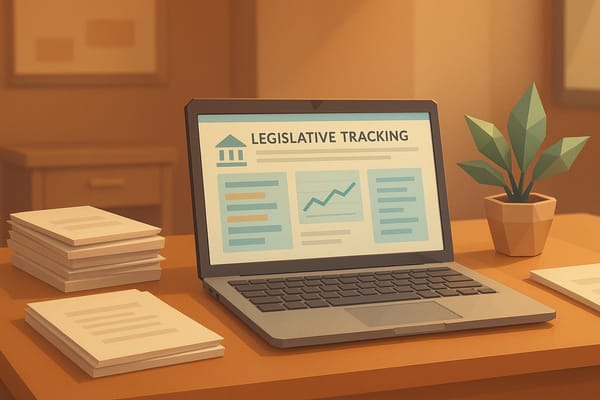Common Legislative Terms: A Plain English Guide
Simplify your understanding of legislative terms and the lawmaking process to engage confidently in government decisions that impact your life.

Understanding legislative terms can feel overwhelming, but it’s key to participating in government decisions that affect your life. This guide breaks down complex terms into simple language, helping you:
- Learn who makes laws and how committees work.
- Understand different types of laws, like bills and resolutions.
- Follow the step-by-step process of how a bill becomes a law.
- Use digital tools to track laws and contact representatives.
Quick Tip: Tools like cicada.guide and Congress.gov simplify legislative tracking, making it easier to stay informed. Whether you’re voting, attending meetings, or sharing opinions with lawmakers, this guide empowers you to engage confidently in the legislative process.
How a Bill Becomes a Law
Who Makes Laws
Understanding who makes laws helps you stay informed about how government decisions are made. In the U.S., Congress - made up of the House of Representatives and the Senate - handles federal lawmaking. Let’s break down the key players and their roles.
House and Senate Members
The House of Representatives includes 435 voting members, with seats distributed among all 50 states. To qualify as a representative, you must be at least 25 years old, a U.S. citizen for seven years, and live in the state you represent.
The House operates under a structured leadership system:
| Position | Role |
|---|---|
| Speaker of the House | Oversees House proceedings |
| Majority/Minority Leaders | Set legislative priorities for their party |
| Party Whips | Ensure party members vote in line |
For a bill to pass in the House, it needs at least 218 votes (a simple majority). In the Senate, 51 votes out of 100 are needed for approval.
How Committees Work
Committees are where much of the legislative work happens. The House has over twenty permanent committees that:
- Review and analyze proposed laws
- Hold hearings to gather public input
- Revise bills with amendments
- Decide whether a bill moves forward or is shelved
- Draft "clean bills" that reflect major revisions
When the House and Senate pass different versions of a bill, conference committees step in to reconcile the differences and produce a single version. While committees handle internal processes, outside influences also play a big role.
Outside Influences on Laws
External groups often shape legislation through lobbying and grassroots campaigns. Interest groups, in particular, influence the process by:
- Supporting lawmakers who align with their goals
- Offering policy expertise to guide legislation
- Focusing on key committee members
- Shaping budget decisions
One example of their impact is the "Taxpayer Protection Pledge", signed by 95% of Republican Congress members, committing them to oppose tax increases unless offset by tax cuts.
Campaign contributions are tightly regulated:
- Political Action Committees (PACs) can donate up to $5,000 per candidate per election
- PACs are capped at $15,000 annually for contributions to national political parties
- Individuals can contribute up to $5,000 per year to PACs
Types of Laws and Proposals
Understanding the different types of legislative documents can help you stay informed and even influence changes in the law.
What Bills Are
Bills are the backbone of the legislative process in Congress and are labeled as "H.R.". They come in various forms, each serving a specific purpose:
| Type | Description | Example Use Cases |
|---|---|---|
| Public | Applies to the general population | Federal budget, healthcare |
| Private | Targets specific individuals/groups | Immigration cases, land claims |
| Permanent | Sets long-lasting legal standards | Civil rights legislation |
| Temporary | Addresses short-term issues | Emergency funding measures |
What Resolutions Do
Resolutions differ from bills and serve more specialized purposes. The three main types include:
- Simple Resolutions (H.Res.): Apply to one chamber of Congress and handle internal matters.
- Concurrent Resolutions (H.Con.Res.): Affect both chambers but don’t carry the force of law.
- Joint Resolutions (H.J.Res.): Operate like bills and can become law with full approval.
"There is no real difference between a joint resolution and a bill." - U.S. Senate
Changes to Laws
Existing laws can be updated or revised through amendments. Tools like Congress.gov, the Senate Calendar of Business, or contacting LEGIS at 202-225-1772 can help you track these updates.
Once a bill is fully approved, it becomes a public law and is assigned a unique reference number.
How Laws Get Made
Starting a New Bill
Every bill starts as an idea, which can come from a Representative, Senator, or even an everyday citizen. In the House, a Representative introduces a bill by placing it in the "hopper", a special box at the Clerk's desk. In the Senate, a Senator and their staff draft and introduce the bill.
Here’s a quick comparison of how bills are introduced in the two chambers:
| Stage | House of Representatives | Senate |
|---|---|---|
| Bill Prefix | H.R. | S. |
| Introduction Method | Placed in the hopper | Introduced by a Senator |
Once introduced, the bill goes to a committee for review. Committees hold public hearings where experts and stakeholders provide input. During "mark-up" sessions, members discuss, suggest changes, and vote on amendments. After this stage, the bill moves to the full chamber for debate.
Discussion and Voting
After committee review, the bill heads to the floor for debate. Members of each chamber discuss, propose amendments, and vote on the bill. If both chambers pass different versions, a conference committee works to create a single version that both must agree on.
When all differences are resolved, the bill is ready for the final step: presidential review.
Final Steps to Become Law
The President has three options when a bill reaches their desk:
-
Sign the bill
The bill becomes law immediately. -
Veto the bill
The bill is sent back to Congress. Congress can override the veto with a two-thirds majority in both the House and Senate. -
Take no action
If Congress is in session, the bill becomes law after 10 days without a signature. If Congress is not in session, it results in a "pocket veto", and the bill does not become law.
Digital Tools for Following Laws
cicada.guide: Track and Learn About Laws

cicada.guide simplifies legislative tracking with the help of AI. It monitors 225,503 state bills, 303,554 bill documents, and 7,802,762 votes from 6,433 officials. This platform makes legislative information easier to understand and act on by breaking down complex legal language.
The platform offers three main feeds to organize legislative details:
| Feed | Purpose | Benefits |
|---|---|---|
| For You | Personalized recommendations | Displays bills tailored to your interests |
| Discover | Latest legislation | Explore current bills by topic |
| Tracking | Starred bills | Keep tabs on specific legislation |
With AI-powered summaries, users can quickly grasp the essence of complicated bills. The platform also makes it easy to contact representatives about critical issues and provides insights into elected officials' voting records, helping users see how their values align with those of their representatives.
"Building the infrastructure for democracy in the 21st century" - cicada.guide
More Tools for Citizens
In addition to cicada.guide, tools like LegiScan offer more options for tracking legislation. LegiScan covers over 107,000 legislative items across all 50 states and Congress, with various subscription plans:
| Service Level | Coverage | Annual Cost |
|---|---|---|
| OneVote | Basic public tracking | Free |
| OneVote+ (Single State/Congress) | Enhanced features for one jurisdiction | $25 |
| OneVote+ (National) | All states and Congress | $1,000 |
| GAITS Pro (Single State/Congress) | Advanced tools for one jurisdiction | $100 |
| GAITS Pro (National) | Professional tools nationwide | $3,000 |
To make the most of these tools, focus on tracking key legislation with relevant keywords. Include steps like monitoring implementation phases and potential court challenges to stay fully informed.
Summary
Getting Involved in Lawmaking
Understanding legislative terms can help you actively participate in shaping laws. Here are some ways to get involved:
| Action | Purpose | Impact |
|---|---|---|
| Monitor Issues | Follow specific topics | Stay updated on bills that align with your interests |
| Engage Your Representatives | Share your opinions | Provide informed feedback to influence policy decisions |
| Offer Public Feedback | Contribute to rulemaking | Play a role in shaping how laws are carried out |
| Collaborate with Advocacy Groups | Join forces with others | Strengthen your voice and work collectively for change |
"Congress.gov is the official website for U.S. federal legislative information."
These steps can help you better understand and engage with the legislative process.
Main Points to Remember
Here are the key takeaways from this guide:
- Digital Resources: Online tools now provide easy access to legislative information, simplifying civic engagement.
-
Effective Monitoring: Use tracking tools to stay on top of critical updates for bills that matter to you, including:
- Committee hearings and decisions
- Amendments and revisions
- Final voting outcomes
- Implementation schedules
- Practical Engagement: Make your voice heard by presenting well-supported arguments when contacting lawmakers. Use resources like ProQuest Congressional for legislative histories and check state legislative websites for real-time updates.




